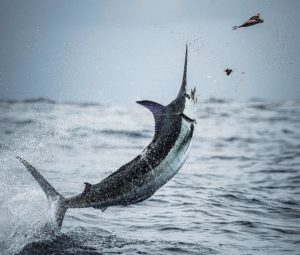Recently, a very good captain down in Guatemala (Chico on Release), who fishes out of Casa Vieja, asked me, “Why do blue marlin in the Atlantic fight harder than the blue marlin here in the Pacific? The fish here stay near the surface and do not dive down deep and fight to stay down like they have done when I was fishing in Cuba and the Caribbean.”
It was a good question. There’s no single good answer, but any fish that fights near the surface is easier to catch than one that makes deep dives. Sailfish, dolphin, tuna and amberjacks are all highly prized game fish and known as strong fighters, but dolphin and sails are much easier for kids to catch, and world records based on line class are heavier for jumping fish that stay near the surface than for species that make deep dives and fight to stay down. Fish like tuna just fight harder!
When we caught record numbers of bluefin tuna in Hatteras, North Carolina, one of the reasons we caught so many in very short periods of time was because of the depth of the water. Like the billfish off Guatemala, these tuna did not make deep dives, but, unlike the marlin off Guatemala, it was because they were in shallow water.
When Stewart Campbell came to tuna fish with us in Hatteras, we intended to experiment with our drag settings to see how much drag we could get away with during both the early high-speed runs of the fish and the later slower-moving stages, where the friction of the line in the water was not as great. We chose to use 80-pound IGFA-class line and fished with a single rod and reel, often hooking the fish with the swivel still at the rod tip.
A major factor was that I had the controls on an agile, highly maneuverable G&S boat, Raptor. In a single day, we learned more about the limitations of 80-pound-class line than we could have learned in a lifetime of chasing blue marlin around the world.
We started with a relatively modest 26 pounds of drag at our strike setting. In the shallow water (around 180 feet deep) where the tuna were feeding, they could make fast runs but could not dive deep. With aggressive boat handling, we chased the fish, on plane in forward gear, and the tuna rarely got much over 100 yards of line off the reel in its first mad dash. Then, after the fish had burned all the available oxygen in its bloodstream, it would stop running and try to get a new supply of oxygen. That’s when Campbell, an expert angler, began pushing the drag up in order to put even more pressure on the fish, eventually to as much as 60 pounds.
With the fish swimming slowly, in a state of oxygen debt and trying to catch its breath, the friction of the short length of line in the water was minimal. The reel remained almost full of line, and there was little or no increased drag due to a diminished spool diameter. Good IGFA 80-pound-class line should not, and did not, break at a true 60 pounds of drag, which is only three-quarters of its true breaking strain. However, we did need to switch from the 80-pound stick that we started with to one of my light 130-pound-class rods.
The water off Guatemala’s Pacific coast is plenty deep, but due to the oceanographic conditions, with upwellings of nutrient-laden water from the depths, there is an “anoxic zone,” an area close to the surface with low levels of dissolved oxygen, that keeps blue marlin from diving to the depths to which they commonly sound in other tropical waters.
Again, fish that stay on or near the surface are easier to catch than those that dive deeply and must be hauled back to the surface.
I’ve also noticed that both blue marlin and bluefin tuna caught in cold water off New England or Madeira do not fight as ferociously as fish of the same size would if hooked in the Bahamas, off Hawaii, or in other waters with a higher surface temperature and colder water found only at greater distances below the warm surface water.
Dr. Barbara Block reported increased mortality in bluefin tuna that were fought and released in warm water, but most of her work in the Gulf of Mexico was from commercial craft without the transom tuna doors available to scientific crews in places like Hatteras and New England. In a friendly bet on the difference in survival rates, I’d put my money on it being due to the ease and speed of handling on the sport boats.
Whether it is the depth or water temperature that makes fish stay near the surface, this behavior does make it easier for an angler to catch big fish on relatively light line. Any fish weighing eight or 10 times the breaking strain of the line is a big fish, but it is going to be easier to catch that fish if it stays near the surface.







